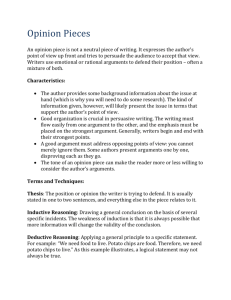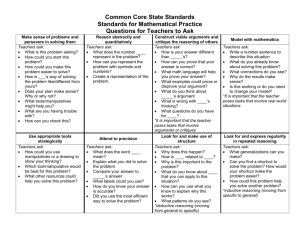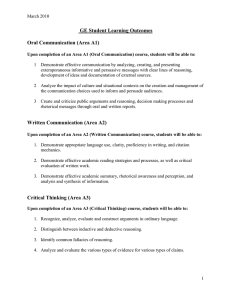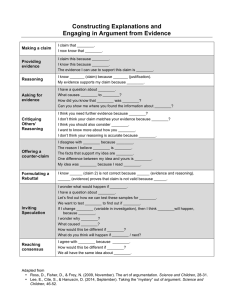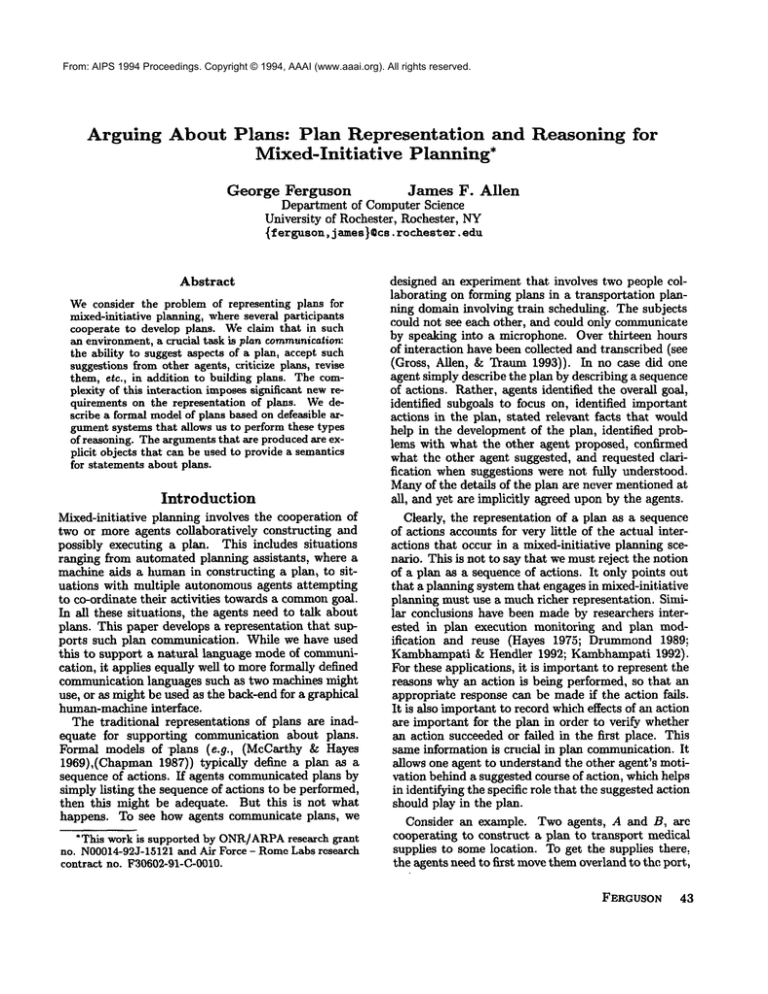
From: AIPS 1994 Proceedings. Copyright © 1994, AAAI (www.aaai.org). All rights reserved.
Arguing
About Plans:
Plan Representation
and Reasoning
Mixed-Initiative
Planning*
George
for
Ferguson
James F. Allen
Department of Computer Science
University of Rochester, Rochester, NY
{ferguson,
j ames}@cs,
rochester,
edu
Abstract
Weconsider the problem of representing plans for
mixed-initiative planning, where several participants
cooperate to develop plans. V~re claim that in such
an environment,a crucial task is plan communication:
the ability to suggest aspects of a plan, accept such
suggestions from other agents, criticize plans, revise
them, e~c., in addition to building plans. The complexity of this interaction imposessi$’nificant newrequirements on the representation of plans. Wedescribe a formal modelof plans based on defensible argumentsystems that allows us to perform these types
of reasoning. The argumentsthat are producedare explicit objects that can be used to provide a semantics
for statements about plans.
Introduction
Mixed-initiative planning involves the cooperation of
two or more agents collaboratively
constructing and
possibly executing a plan. This includes situations
ranging from automated planning assistants,
where a
machine aids a human in constructing a plan, to situations with multiple autonomous agents attempting
to co-ordinate their activities towards a commongoal.
In all these situations, the agents need to talk about
plans. This paper develops a representation that supports such plan communication. While we have used
this to support a natural language mode of comnmnication, it applies equally well to more formally defined
communication languages such as two machines might
use, or as might be used as the back-end for a graphical
hmnan-machine interface.
The traditional representations of plans are inadequate for supporting communication about plans.
Formal models of plans (e.g., (McCarthy & Hayes
1969),(Chapman 1987)) typically define a plan
sequence of actions. If agents communicatedplans by
simply listing the sequence of actions to be performed,
then this might be adequate. But this is not what
happens. To see how agents communicate plans, we
*This work is supported by ONR/ARPA
research grant
no. N00014-92J-15121and Air Force - RomeLabs research
contract no. F30602-91-C-0010.
designed an experiment, that. involves two people collaborating on forming plans in a transportation planning domain involving train scheduling. The subjects
could not see each other, and could only communicate
by speaking into a microphone. Over thirteen hours
of interaction have been collected and transcribed (see
(Gross, Allen, & Traum 1993)). In no case did
agent simply describe the plan by describing a sequence
of actions. Rather, agents identified the overall goal,
identified subgoals to focus on, identified important
actions in the plan, stated relevant facts that would
help in the development of the plan, identified problems with what the other agent proposed, confirmed
what the other agent suggested, and requested clarification when suggestions were not. full)’ understood.
Manyof the details of the plan are never mentioned at
all, and yet are implicitly agreed upon by the agents.
Clearly, the representation of a plan as a sequence
of actions accounts for very little of the actual interactions that occur in a mixed-initiative planning scenario. This is not to say that we must reject the notion
of a plan as a sequence of actions. It only points out
that a planning system that engages in mixed-initiative
planning must use a muchricher representation. Similar conclusions have been made by researchers interested in plan execution monitoring and plan modification
and reuse (Hayes 1975; Drummond1989;
Kambhampati & Hendler 1992; Kambhampati 1992).
For these applications, it is important to represent the
reasons why an action is being performed, so that an
appropriate response can be made if the action fails.
It is also important to record whicheffects of an action
are important for the plan in order to verify, whether
an action succeeded or failed in the first place. This
same information is crucial in plan communication. It
allows one agent to understand the other agent’s motivation behind a suggested course of action, which helps
in identifying the specific role that the suggested action
should play in the plan.
Consider an example. Two agents, A and B, arc
cooperating to construct a plan to transport medical
supplies to some location. To get the supplies there,
the agents need to first movethem overland to the port,
FERGUSON 43
From: AIPS 1994 Proceedings. Copyright © 1994, AAAI (www.aaai.org). All rights reserved.
and then carry them by ship. A cargo ships leaves every day at between 4:00 and 6:00. If the supplies are
movedby train to the ship, they will arrive at 5:00.
If they are movedby truck, they will arrive at 3:00.
Moving them by truck, however, will be three times
as expensive. Given this scenario, there are competing constraints on a solution. Ideally, one would like a
plan that guarantees to get the supplies there as soon
as possible, while spending the least amount of money.
Such a solution is not possible here, however. Furthermore, there is no single, global evaluation measure on
the worth of plans. Each of the agents may have different priorities in evaluating plans, possibly focusing
on one factor and ignoring the others.
Given this setting, one possible interaction between
the two agents is as follows:
1. Agent A suggests shipping the supplies by train;
2. Agent B points out that the ship might leave at 4:00,
and thus the supplies would miss today’s ship;
3. Agent A points out that the ship might not leave
until 6:00, and thus the supplies would make today’s
ship.
At this point, the agents are at a standoff. They could
continue to argue in many ways. A might argue that
getting the supplies there today isn’t important, or B
might argue that the risk of missing the ship is unacceptable. Or one of them might propose another plan:
4. Agent B suggests moving the supplies by truck instead.
Assuming that agent A finds the cost of this option
acceptable, there would appear to be no arguments
against this plan, aa~d thus it would be accepted by
both agents.
There are manyproblems to address in order to support the type of interactions in the example. In this
paper we are concerned with the formal representationai underpinnings. The representation proposed involves applying techniques for representing arguments
to a logic of time, events and action, which supports
reasoning about attempting actions and their effects.
Wehave explored the logic of time and action in depth
elsewhere (Alien & Ferguson 1994) and have applied
it to plan reasoning (Allen 1991). Here we explore the
use of explicit argumentstructures in a direct inference
system, and show how, with a suitable logic of time and
action, they provide a very rich representation both for
talking about plans and for doing plan reasoning itself.
This representation is being used to support plan reasoning in the TRAINSsystem at Rochester, where it
supports plan construction and plan recognition algorithms that are used by a planning system that cooperatively builds plans with a person.
The rest of this paper is organized as follows. First
we define argument systems formally, then apply the
model to representing planning knowledge. The preceding example is used to illustrate the approach. Finally we discuss someof the issues raised by this work.
44
REVIEWED
PAPERS
:’"’-~
Goals
Figure 1: Graphical representation
of an argument
Argument
Systems
In this section we present a formal description of an
argument system based on those of Loui (Loui 1987)
and of Pollock (Pollock 1987; 1992).
Basic Definitions
Weassume a logical language with an entailment relation ~, and allow a set KB of propositions that specify domainconstraints against which argnments (’all be
evaluated.
Definition 1 An ARGUMENT STEP is a pair (~,p),
written ’~ -~ p," where ~ is a set of propositions (the
PREMISES) and p is a single proposition (the CONCLUSION).
An argument step is to be read somethiug like "@ is
reason to believe p," or "The truth of ep lends support
to the truth of p."
Amagent’s knowledge base includes a set of argument steps A that the agent uses in its reasoning. Note
that in the case where we have large numbers of potential arguments, A may be specified schematically.
Definition
2 An ARGUMENT is
steps {((I),,pi)} drawnfrom
a set
of
argument
Definition 3 The PREMISES of an argument A are
those propositions in the conclusions of steps with
empty premises, i.e.,
{pl(O,p) E A}. The CONCLUSIONSof an argument A are. the union of the premises
o/steps with empty conclusions, i.e., [J{~l(~,~) E A}.
Werequire that arguments be non-circular and that
both Premises(A) and Goals(A) be non-empty for
any argument A. In this case, arguments correspond
to directed, acyclic graphs labeled with propositions,
such as illustrated in Figure 1. Anargumentstep (~: p)
corresponds to a node labeled by p with children each
labeled by an element of ~. The sources of the graph
correspond to Premises(A), the sinks to Goals(A).
Conflict
and Defeat
What makes argument systems interesting is the way
,arguments can conflict over the status of some proposition. In this case, we need to define howcertain arguments are to be preferred over others.
Definition 4 Two argument steps (~,p)
CONFLICT
if p and q are inconsistent.
and (~,q)
From: AIPS 1994 Proceedings. Copyright © 1994, AAAI (www.aaai.org). All rights reserved.
In Pollock’s system, this form of conflict is called rebuttal, and a second form, called undercutting, is also
permitted. The intuition is that in rebutting conflict
the value of ~omeproposition is at issue, while in undercutting conflict it is the applicability of a defeasible
rule that is in doubt. In our approach, following Loui,
we will impose certain criteria of defeat (below) which
to some extent obviate the need for undercutting. We
leave open the possibility, however, that it maybe required in the future.
Given two arguments that conflict, we are interested
in preferring certain arguments over others. The following definition, adapted from Loui, makes this explicit:
Definition 5 An argumentA is AT LEAST AS SPECIFIC as an argument B if there is a step (~,p) E
and a step (ql,q) e B such that the steps conflict and
~ q~. An argument is MORESPECIFICthan another
argumentif it is at least as specific and the converse is
not the case.
Finally, we can put these pieces together and propose
the following:
Definition
6 An argument A DEFEATS an argument
B if A conflicts with B and A is at least as specific as
B.
Definition 7 An argument A is UNDEFEATEDif there
is no argumentB that conflicts with A that is not itself
defeated.
There are complications in applying this somewhatcircular definition to determine which arguments are undefeated. Pollock (Pollock 1992), for example, considers such phenomenaas collective defeat and self-defeat.
The details are not necessary to an appreciation of the
formalism as regards planning.
Also, there might be other grounds for preferring one
argument over another besides specificity. Loui (Loui
1987) considers evidence, directness, and preferred
premise, for example. As weU, there might be domainspecific criteria, such as resource use or time limits in
a planning context. The specificity principle is generally accepted as appropriate and is sufficient for what
follows.
supporting the fact that executing certain actions will
achieve certain goals. These arguments may be in
conflict with or defeated by other arguments. Undefeated arguments represent plans that will succeed,
given what we know and how long we searched for
counter-arguments. Of course, plans can be conkpared
or evaluated according to other factors besides defeat,
such as resource usage or time constraints. Note that,
amongother things, this approach distinguishes goals
from other effects and makes the assumptions underlying the plan explicit and thus available for reasoning.
Plan
Reasoning
Using
Arguments
In this section we describe the application of argument
systems to planning problems. Webegin by describing
the representation of causal knowledge using defensible rules and consider the qualification problem in this
fight. Wethen present a formalization of the mixedinitiative planning examplepresented earlier. This is a
short but interestingly complex example of a planning
problem that highlights the incrementality of argumentation and the use of specificity. The exampleincludes
reasoning about uncertainty and external events.
The approach is to express our defeasible knowledge
about actions and their preconditions and effects using rules in A. Arguments can then be constructed
Causal Knowledge and Qualifications
The fundamental issue in representing knowledge for
planning is how to capture the idea that execution of
an action causes a certain effect, at least under certain
conditions. The traditional
planning view would be
characterized something like the following:
Holds(preconds(a), t) A Try(a, t,
Holds(effects(a), n(t)
That is, if the preconditions of an action a hold at time
t and we attempt action a, then the effects will hold
at the next time point) There are many problems
Knowledge
Representation
To keep the presentation as concise as possible, we will
use a very simple representation of time, namely a discrete modelwhere, given a time t, n(t) is the next time.
The representation can easily be generalized to either
a situation calculus representation or the more expressive interval temporal logic (Allen & Ferguson 1994)
that we actually use. An important point is that action attempts must be distinguished from their effects.
In order to do this, we introduce events as cognitive objects that correspond to "something that happened." Event predicates are used to organize our
causal knowledge about the domain and are organized
in a type hierarchy. For example, a predicate like
Load(et) is true if the event et describes a loading event
that occurred at time t. Rules describe the necessary
conditions given that an event of a particular type occurred.
In order to reason about the agent’s abilities,
we
have to introduce actions. Unfortunately, actions and
events are often confused, since, intuitively, for any
action there is an evdnt corresponding to that action
being executed. To avoid this confusion, we will think
of actions as sensory-motor programs that can be run
by the agent; this is basically the concept of action
used in the planning literature. There is a predicate
Try(Tr, t, et) which is true if programr is executed at
time t (or over inter~-al t in a more expressive logic)
causing event et to occur. Rules specify sufficient conditions for a program’s execution to result in an event
of a certain type.
1Traditional models wouldn’t have events, but we
include the et term for comparison with the later
FERGUSON 45
From: AIPS 1994 Proceedings. Copyright © 1994, AAAI (www.aaai.org). All rights reserved.
with this definition, such as how to handle simultaneous actions, external events, and actions with duration.
These problems can be resolved, however, by using a
richer temporal model, but for this paper such extensions are not important. The important idea is the
intuition that actions do have preconditions, even if
these are context-dependent and subject to revision.
In the context of reasoning about actual situations,
what is troubling is the strength of the implication. It
does not make sense with this definition, for exaanple,
to reason about execution of the action when only some
of the preconditions arc knownto be, true. Indeed, in
the STRIPS model of planning, all operator cannot
evcn bc applicd (i.e., an action cannot be attempted)
if all the preconditions do not hold. In a nmre philosophi(:al sense, these axioms rml into the qualification
p.lvblem: the problem that no matter how mmlypreconditions we write down, there will always be other
things that might happen that would invalidate the axiom. If these axioms are based oil the material conditional, the price of encountering an unconsidered qualification is inconsistency.
The obvious movethen is to weakenthe definition to
use the defcasiblc connective "--~" rather than the material conditional. Then these definitions caal be used
in arguments that execution of an action has some effect, without saying finally that it nmst. Weobtain
sonmthing like thc following, using the notation introduced in the previous section:
{ Holds(preconds(a),t): Try(a, t, et) -- + Event(eL)
where Event is an event-type predicate. The definition of the event can continue to use tile material conditional:
Ereut(e t ) DHolds(cffects(e t ), .n(
This is not quite enough, however, because it doesn’t
capture tile notion that somehow the precondition
should be true before attempting the action if it is
to succeed, even if we don’t knowfor sure that it this
is the case. Clearly we shouldn’t state that falsity of
a precondition implies that the action won’t succeed,
since there might be other conditions (known or unknown) under which it would. But we can say that
defeasibly, as in
{-~Holds(precouds(a),t), Try(a, t, et) } ~ -~Event(et
In fact, these two rules form the extremes of a continuum of rules relating knowledgeof preconditions to
successful execution of actions. Suppose we knowthat
¢, and .62 are preconditions for action a. Then a plan
that takes account of only Ct is at least reasonahlc, if
not complete or even possible given other knowledge
about the world. But it. is important to be able to
represent such partial or incorrect plaais if we are interested in doing more thm~ simply generating sinq)le
development.
46
REVIEWEDPAPERS
plans. In this case, we will need additional rules in A
corresponding to these "partial" argument steps. In
fact, for every action a with (conjunctive) preconditions ~bl, ¢9.,..., d,~ and effects ¢, there corresponds a
set of defeasible rules orgaafized in a lattice of specificity. The most specific rule is the one in which all
pre(’onditions are present. The least specific rule mentions no preconditions, i.e., Try(a, t, e ) --~ Er,e.nt(e),
indicating that aal action can always be attemptcd,
even if an argumentthat doesn’t take note of preconditions maynot be a very strong one. There is a similar
lattice of rules regarding the falsity of preconditions
and the non-occurrence of events.
Sonm comments are in order regarding this tbrmu]ation of causal rules. First, it is independent of the
underlying representation of time aald action, so hmgas
action attempts ca~l be distinguished from thcir effects
(i.e.. the Try predicate, above). Second, the approach
is different from using a modal logic to express the
possibility and necessity intuitions involved in rea.~oning about preconditions. The most nmdal logic could
do is allow us to write that if a precondition is true
then an action is possible, and if it is false then the
action necessarily fails, for example. But in the defeasible reasoning approadb degrees of support are afforded through the use of defeasible rules with more
or less specifc aaltecedents. This is muchcloser to our
intuitions about just what a precondition is, and also
closer to the way people talk about preconditions in
collaborative discourse about plans.
Finally, we believe that this approach to reasoning
about preconditions and effects of actions is the best
way to deal with the qualification problem. That is,
the agent considcrs qualifications ,as long as it can or
until it has considered all that it knowsabout, as reflected in its set of defeasiblc rules. If subsequentqualifications are encountered, they can be reasoned ahout
given more time, without denying that the plan developed previously supported its conclusions, however
tenuously.
Planning
Example
Recall from the example presented in the Introduction
that we have to get supplies X into ship S before it
leaves port P, and that there are two ways of transporting the supplies. Wewill denote these by two actions (programs): sendByTrain, mid sendByTruck.
Then a,ssuming these actions have no preconditions.
their (tefinitions are given by tile fi)llowing rules:
{ Try( sendByTrain(
x, l), t, et ) } -~ Tran.slgn’t(et , x, 5)
{Try(sendByTruck(x,l), e,) } -~ Transport(or, :r, l, 3).
Time units are nmasuredin hours. The (went predicate
Transport is defined as
Transport(et, x, l, n.) D At(x, l, t +
The action of loading ship s with supplies x h,as as
preconditions that both the ship and the supplies nmst
From: AIPS 1994 Proceedings. Copyright © 1994, AAAI (www.aaai.org). All rights reserved.
be at the dock, yielding the following definition:
(At(x, l, t), At(s, l, t), Try(load(x,s, l), t,
Load(et,x, s, i).
The definition of Load is
Load(et,x,s,l) D In(x,s,t 1)
Finally, we have the infor-,ation that the ship S leaves
port P between 4:00 and 6:00. Letting Td denote the
time of departure, we have that 4 < Td < 6 and defeasible rules:
Td > t ~ At(S,P,t)
Td <_ t -~ -~At(S,P,t).
Agent A’s initial plan, namely shipping the the supplies by truck, is shownin Figure 2(a). Obviously, this
ignores the precondition that the ship be at the dock
at the time of loading. Figure 2(b) shows agent B’s
a more specific argmnent that argues that the loading
will fail if the ship leaves at 4:00. Figure 2(c) shows
the equally specific argument supporting the successful
loading of the supplies if the ship hasn’t left yet. Since
neither argument is more specific, neither emerges as
undefeated and so, intuitively, neither plan is guaranteed. This is as it should be given the nncertainty in
the scenario. Figure 2(d) shows the undefeated argument for using the truck rather than the train.
The point of this example is to demonstrate the incremental development of a plan when several agents
axe involved. By representing the interaction as a process of argumentation, we can account for interactions
that point out of difficulties with a current proposal,
or that propose alternative courses of action, as well
as manyother interactions beyond the scope of a traditional planning system. Further, the arguments that
are built up explicitly include the types of information typically added to planners to support, e.g., plan
modification, while being formally well-motivated in
terms of defeasible reasoning. Of course, the particular exampleused here is not particularly difficult for
classical planning systems, although it does contain
some complications involving uncertainty and external events that would cause problems for many frmneworks.
Towards
A Language
for Plans
The description of plans as arguments allows us to define a language in which plans are objects in the ontology. Terms denoting plans are then given a semantics in terms of plan graphs, where different predicates
imposedifferent constraints on the interpretation (i. e.,
on the graph). There are st~’uctural predicates, such as
ActionIn, Enables, Premise, Goal, etc., that are defined in terms of the structure of the plan graph. Then
there are evaluation predicates. These include absolute
predicates such as Plausible or Impossible and relative
predicates that allow plans to be compared, for exa~nple, according to resource usage or time constraints.
The view of mixed-initiative planning that emerges is
one where agents post constraints on the shared plan
using these predicates.
This language is being developed as part of the
TRAINSproject (Allen & Schubert 1991; Ferguson
1994), an effort to construct an intelligent planning
assistant that is conversationally proficient in natural
language. The plan description predicates are used in
the interface between the language and discourse modules and the domain plaa reasoner. The manager’s
utterances are result in queries being madeof or constraints being posted on the plan. The plan reasoner
communicatesthe results in terms of plan description
predicates that satisfy the query or that needed to be
added in order to connect an utterance to the plan.
These are then used to generate responses or helpful
suggestions, since often information beyond the literal
content of an utterance must be added in order to incorporate it.
Discussion
There are many questions raised by this work, but
space permits discussion of only a few. First, this work
has clear similarities to the work on plan nmdification
and replanning mentioned at the outset. The differencc
is that rather than developing data structures for traditional planners that retain information required for
other tas "ks, we consider plaaning within the context
of a general defeasible reasoning system. Thus, our
work can be seen as a generalization and formalization
of that work which can be applied to other problems
involved in plan communication. Our approach also
abstracts away from the underlying representation of
action (i.e., STRIPS).
Konolige (Konolige 1988) applies defeasible reasoning to reasoning about events, in particular to the Yale
Shooting problem. The emphasis is on what types of
defeasible arguments are important, in reasoning about
events as well as what information is necessary for adjudicating between these arguments. While the particular rules presented axe largely an artifact of the simple representation of action, he argues convincingly for
the relative merits of argumentation systems compaxed
to indirect systems such as circumscription. He notes
the ability to include knowledgeabout applicability of
defeasible rules directly within the franmworkand the
incremental nature of argumentation that we have also
noted.
Konolige and Pollack (Konolige & Pollack 1989) directly apply the defeasible reasoning paradigm to plan
recognition in the context of plans-as-intentions. The
aim is to produce plausible arguments regarding the
intentions of other agents from observations of their
actions, and from the undefeated arguments to extract
intentions that can be ascribed to those agents. The
difference between our approaches is that we see the arguments as objects to be reasoned about rather than
using argumentation to reason defeasibly about intenFERGUSON
47
From: AIPS 1994 Proceedings. Copyright © 1994, AAAI (www.aaai.org). All rights reserved.
In(X,s, 6)
t
Load(es, X, S, P)
/
-~Load(es, X, S, P)
-,,,.
/
At(X,P, 5)
At(X, P, 5)
~ ~’~At(S,
P, 5)
l Try(load(X, S, P), 5, es)
Transport(eo, X, P, 5)
Td = 4
l Try(load(X, S, P), 5,
Transpm’t (Co, X, P, 5)
t
t
Try( sendByTrain( X, P), O,
Try (sendByTrain( X, P), O,
(a)
(b)
In(X,S,3)
Load(e3,
X, S, P)
Load(es, X, S, P)
/
At(X, P, 5)
(S, P, 5)
t Try(load(X, S, P), 5, es)
Transport(eo, X: P, 5)
Ta = 6
t
At(X,P, 3)
"....
~ Try(load(X,
Tra.nst~rrt( eo, X, P, 3)
S, P), 3, ea)
t
(d)
Try( sendByTruck( X, P), O,
Try( sendByTrain( X, P), O,
(c)
Figure 2: Four arguments about shipping supplies
tions. These are not irreconcilable
viewpoints.
Conclusions
Wehave presented an explicit representation of plans
as arguments that a certain course of action under certain explicit conditions will achieves certain explicit
goals. Webelieve that in realistic mixed-initiative
planning scenarios such a representation is necessary to
capture the wide range of reasoning that agents do with
plans. Basing the representation on argument systems
provides a formal basis both for describing these forms
of reasoning and for defining the semantics of plans.
References
Allen, J. F., and Ferguson, G. 1994. Actions and
events in interval temporal logic. J. Logic and Computation, Special Issue on Actions and Processes. To
appear.
Allen, J. F., and Schubert, L. K. 1991. The TRAINS
project. TRAINSTechnical Note 91-1, Dept. of Computer Science, U. of Rochester, Rochester, NY.
Allen, J. F. 1991. Temporal reasoxfing and planning.
In Reasoning about Plans. San Mateo, CA: Morgan
Kaufmann. 1-68.
Chapman, D. 1987. Planning for conjunctive goals.
Artificial Intelligence 32:333-377.
Drummond,M. 1989. Situated control rules. In Proceedings of KR-89, 103-113.
Ferguson, G. 1994. Domainplan reasoning in trains93. TRAINSTechnical Note 93-2, Dept. of Computer
Science, U. of Rochester, Rochester, NY. To appear.
48
REVIEWEDPAPERS
Gross, D.; Allen, J. F.; and Traum, D. R. 1993.
The TRAINS-91 dialogues. TRAINSTechnical Note
92-1, Dept. of Computer Science, U. of Rochester,
Rochester, NY.
Hayes, P. J. 1975. A representation for robot plans.
In Proceedings of IJCAI-75, 181--188.
Kambhampati, S., and Hendler, ,]. A. 1992. A
validation-structure-based
theory of plml modification and reuse. Artificial Intelligence 55:193-258.
Kambhmnpati, S. 1992. Characterizing
multicontributor causal structure for planning. In Proceedings of AIPS-9$, 116-125.
Konolige, K., and Pollack, M. E. 1989. Ascribing
plans to agents, preliminary report. In Proceedings of
IJCAI-89, 924-930.
Konolige, K. 1988. Defeasible argumentation in reasoning about events. In Ras, Z. W., and Saitta, L.,
eds., Methodologiesfor Intelligent Systems 3, Proc. of
the Third Intl. Symposium, 380-390. North-Holland.
Loui, R. 1987. Defeat among arguments: A system of defeasible inference. Computational Intelligence 3(2):100-106.
McCarthy, J., and Hayes, P. J. 1969. Somephilosophical problemsfrom the standpoint of artificial intelligence. In MachineIntelligence ,l. American Elsevier
Publishing Co., In(:. 463-502.
Pollock, J. L. 1987. Defeasible reasoning. Cognitive
Science 11:481 518.
Pollock, J. L. 1992. Howto reason defeasibly. Artificial Intelligence 57:1--42.


